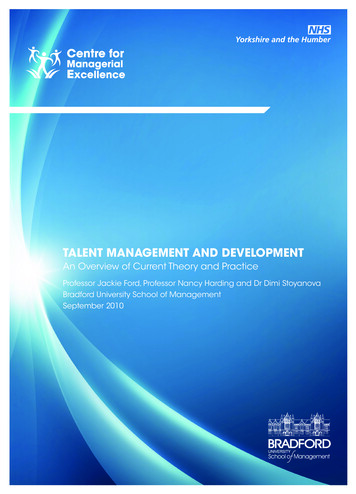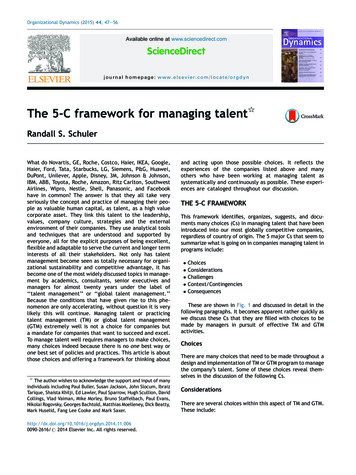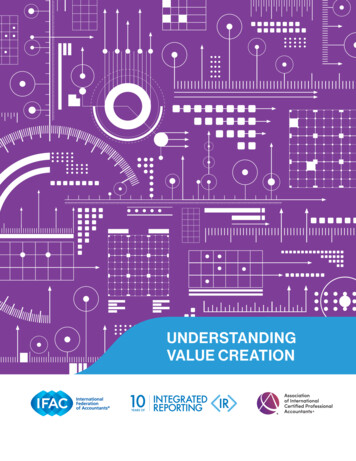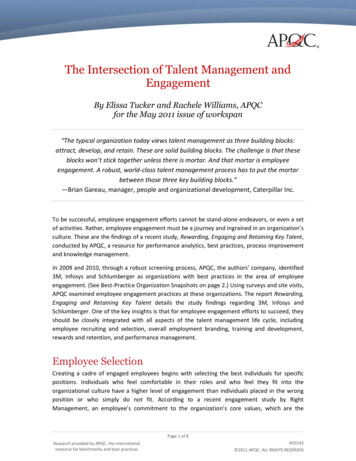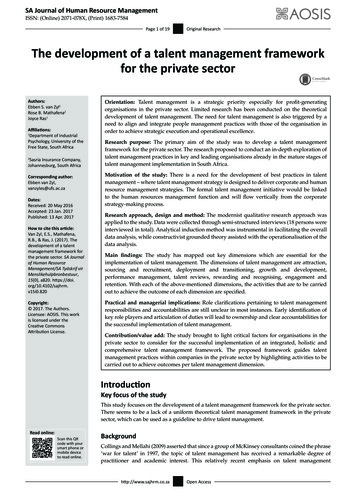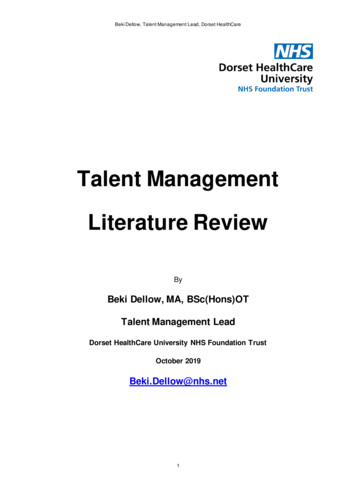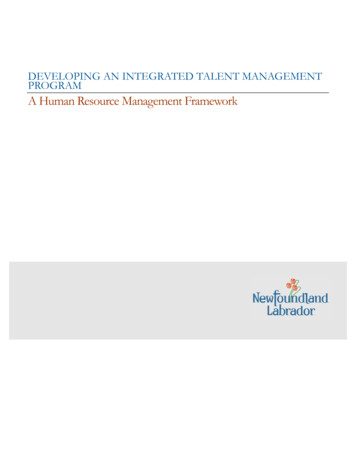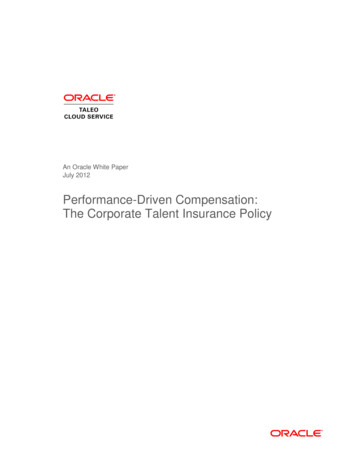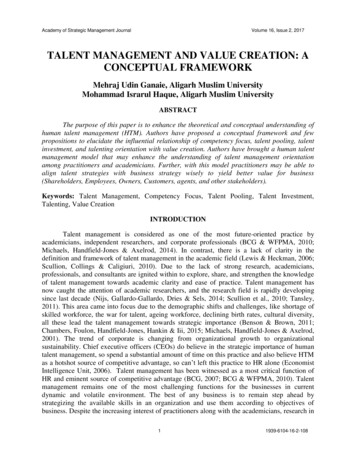
Transcription
Academy of Strategic Management JournalVolume 16, Issue 2, 2017TALENT MANAGEMENT AND VALUE CREATION: ACONCEPTUAL FRAMEWORKMehraj Udin Ganaie, Aligarh Muslim UniversityMohammad Israrul Haque, Aligarh Muslim UniversityABSTRACTThe purpose of this paper is to enhance the theoretical and conceptual understanding ofhuman talent management (HTM). Authors have proposed a conceptual framework and fewpropositions to elucidate the influential relationship of competency focus, talent pooling, talentinvestment, and talenting orientation with value creation. Authors have brought a human talentmanagement model that may enhance the understanding of talent management orientationamong practitioners and academicians. Further, with this model practitioners may be able toalign talent strategies with business strategy wisely to yield better value for business(Shareholders, Employees, Owners, Customers, agents, and other stakeholders).Keywords: Talent Management, Competency Focus, Talent Pooling, Talent Investment,Talenting, Value CreationINTRODUCTIONTalent management is considered as one of the most future-oriented practice byacademicians, independent researchers, and corporate professionals (BCG & WFPMA, 2010;Michaels, Handfield-Jones & Axelrod, 2014). In contrast, there is a lack of clarity in thedefinition and framework of talent management in the academic field (Lewis & Heckman, 2006;Scullion, Collings & Caligiuri, 2010). Due to the lack of strong research, academicians,professionals, and consultants are ignited within to explore, share, and strengthen the knowledgeof talent management towards academic clarity and ease of practice. Talent management hasnow caught the attention of academic researchers, and the research field is rapidly developingsince last decade (Nijs, Gallardo-Gallardo, Dries & Sels, 2014; Scullion et al., 2010; Tansley,2011). This area came into focus due to the demographic shifts and challenges, like shortage ofskilled workforce, the war for talent, ageing workforce, declining birth rates, cultural diversity,all these lead the talent management towards strategic importance (Benson & Brown, 2011;Chambers, Foulon, Handfield-Jones, Hankin & Iii, 2015; Michaels, Handfield-Jones & Axelrod,2001). The trend of corporate is changing from organizational growth to organizationalsustainability. Chief executive officers (CEOs) do believe in the strategic importance of humantalent management, so spend a substantial amount of time on this practice and also believe HTMas a hotshot source of competitive advantage, so can’t left this practice to HR alone (EconomistIntelligence Unit, 2006). Talent management has been witnessed as a most critical function ofHR and eminent source of competitive advantage (BCG, 2007; BCG & WFPMA, 2010). Talentmanagement remains one of the most challenging functions for the businesses in currentdynamic and volatile environment. The best of any business is to remain step ahead bystrategizing the available skills in an organization and use them according to objectives ofbusiness. Despite the increasing interest of practitioners along with the academicians, research in11939-6104-16-2-108
Academy of Strategic Management JournalVolume 16, Issue 2, 2017this area is still in growing stage (Dries, 2013). The research available in this area is mostly thatof conceptual, theoretical, and review based among a few empirical.The focus of this paper is to review the existing relevant literature and to identifydifferent constructs of human talent management (competency focus, talent pooling, talentinvestment and talenting orientation), and their influence on organization’s value creation.Further, propose a conceptual model and few propositions, which may enhance ourunderstanding how talent management orientation influences the value creation of a firm. Futureresearch directions will explain how human talent management researchers will work on theintegration of relationship and contribute towards the maturity of talent management by furtherexploring and validating the model empirically to enhance the body of knowledge.Human Talent ManagementMany researchers believe that talent management is mere rebranding of human resourcemanagement; while we analyzed that it has more specific approaches towards talent (highpotential and high performers). The approach of talent management lies within the boundaries ofHuman Resource Management (Lewis & Heckman, 2006), and based on theories oforganizational behavior and human resource management (Thunnissen, Boselie & Fruytier,2013). In addition to that TM targets, a group of top potential candidates deployed or to bedeployed at companies strategic positions, who contribute towards the sustainable competitiveadvantage (Collings & Mellahi, 2009). One of the most cited definitions in literature describesTalent Management shown in Figure 1 as a strategic process of,“The systematic identification of key positions which differentially contribute to theorganisation's sustainable competitive advantage, the development of a talent pool of highpotential and high performing incumbents to fill these roles, and the development of adifferentiated human resource architecture to facilitate filling these positions with competentincumbents and to ensure their continued commitment to the organisation”(Collings & Mellahi,2009).Figure 1HUMAN TALENT MANAGEMENT AND VALUE CREATION21939-6104-16-2-108
Academy of Strategic Management JournalVolume 16, Issue 2, 2017The focus of TM is to identify the specific key positions which are highly valuable andmake a significant impact on competitiveness of an organization, and then create and develop agroup of high potential employees to fill these positions taking care of an effective HR system asfacilitator for identification of pivotal positions, preparing and developing talent pool to sustaincommitment of talent towards organization. The Crucial function of Talent Management is tomake an organization future-oriented by managing their human capital; it will help them to copeup with different future talent shortages. TM also takes care of both individual andorganizational need in order to find talent within and retain them for tough competition times. Bythis approach, talent managers keep their focus on preparing a group of highly potentialcandidates for organizations future leadership positions (Lewis & Heckman, 2006). Thesepositions are based on roles required at different times, and these requirements are filled with acombination of “internal development and external recruitment” (Collings & Mellahi, 2009). Amore useful definition of talent management is the differential management practices andopportunities available to human capital(talent) in the organization (Blass, 2007). Such processescan be formal and informal, deliberative and unintentional, explicit or implicit. Whatever thecombination, these processes constitute an organization’s talent management system. Using thisdefinition, every organization has a talent management system whether it recognizes it or not.Our definition of human talent management is based on identifying the pivotalcompetencies of key positions/projects, make a substantial investment in developing thesecompetencies in a group of high performers (Hipe) and high potentials (Hipo) available in atalent pool of organization, and create a culture of talenting/knowledge sharing/mutualdevelopment towards a value driven organization. Four distinctive dimensions of human talentmanagement involved in organizational success are competency focus, talent pooling, talentinvestment, and talenting orientation. These are the important tools and well as contributorstowards human talent management and value creation.Competency FocusWe utilized the term pivotal competencies to refer the set of crucial skills (talentcomponent) that organization can develop among high potential (talent) employees towards thevalue driven organization. Competence is one of the essential elements which signifies a talentedincumbent (Gallardo-gallardo, Dries, & González-cruz, 2013; Ulrich, Brockbank, Johnson, &Younger, 2007), once developed in a better way, leads to excellent and exceptional jobperformance (Gallardo-Gallardo et al., 2013). Competency being very old concept having itsfootprints in Roman history, they used to practice a similar function that of competency profilingto detail out the attributes of “good Roman soldier”. The concept of “competency” wasintroduced by Harvard’s distinguished psychologist, David McClelland to the human resource’sbody of knowledge, to improvise the selection procedures of United States Information Agency(McClelland, 1973).Competency mapping has been found to be one of the most important strategy foreffective performance of talent management practices like sucession planning, development andretention (Nair, 2012). Competency-based approaches have been critical to many organizationalfunctions like succession planning, performance management, and human capital planning.These approaches were eminent, as they eased the process of skill, knowledge, ability, andbehavior identification to manage right human capital for current and future needs, aligned withthat of business strategy. These also reduced the gap between the competencies required by aspecific project, a job role, or that of organizational strategy in future and those existing. Pivotal31939-6104-16-2-108
Academy of Strategic Management JournalVolume 16, Issue 2, 2017competencies are more crucial as they contribute to organizational success significantly andcreate value to the business. Competency management has gained special status in talentmanagement practice in both public and private sector, lubricating them in talent attraction,identification, development, deployment, and other core functions of human resources (Mentzas,2006). Figure 2 represents the Competency Focus.H1: Pivotal competency focus has positive influence on Value creationFigure 2COMPETENCY FOCUSTalent PoolingEmployees with high potential and high performance are the key players in anysuccessful organization. Here talent pooling refers to pool up these high potential and highperforming employees who can be exposed to these pivotal competencies to fill the current orfuture key positions of the organization. Creating a talent pool within an organization is the keypractice of human talent management, that can generate value and business competitivenesstowards organizational success by acquiring the pivotal competencies and take strategic keypositions in future (Mellahi, 2009; Mellahi & Collings, 2010; Smilansky, 2006; Stahl et al.,2007). Organizations do identify future requirements of business in terms of skills, knowledge,and capabilities and develop a talent pool to suffice that requirement. These key roles contributedifferentially and create a value to the business by those right people (high performers), whichcannot be done by those of low performers (Heinen & O’Neill, 2004). Right people means theperson from talent pool, having the right skill means competencies, right time and place meanscurrent or future deployment of the talent at the key positions or key projects, willingness andcommitment to do, and being a part of brand wagon for substantial contribution, all this leads tothe management of talent towards value creation, competitiveness, and organizational success(Ulrich & Smallwood, 2010). Figure 3 represents Talent pooling.H2: Talent pooling orientation has positive influence on Value creationTalent InvestmentEmployers with a clear focus and those consistently revitalize their commitment andinvest in long-term talent management, are making all possible efforts to be a clear choice amongbest-in-class talent available. Even the recession has not affected the talent investments; it showsthe significance of maintaining the best talent pipeline for your organization. It’s actually thetalent which pulls you out of those bad times, Caterpillar believed in that “mantra” and decidedto invest 1.5 billion in research and development immediately after the recession to maintainthe best pipeline of engineers available for both good and bad times (Ed, 2009). Investing in41939-6104-16-2-108
Academy of Strategic Management JournalVolume 16, Issue 2, 2017knowledge development, R&D, and new structures which will foster innovation and to markdifference (Daum, 2003).Meanwhile, it has been noticed that investments in people around many organizationshad become unproductive and challenging, because of improper utilization of funds ormisalignment between human talent strategy and business strategy. These inefficiencies can beoptimized by properly aligning the talent strategy with that of business strategy. While adoptingthis practice it has been observed that along with optimal usage of investment in talentdevelopment the current talent gaps are also exposed. This approach develops a sense of trust,motivation among the talent who have potential to create value for the organization and greaterreturns on investment (Aguirre, Harshak, Post & Storr, 2012). Talent Investments (investmentmade is enhancing the knowledge, capabilities, and engagement in people of organization) addsvalue to the business when they are aligned to business strategy, are customer focused, directedat motivating and valuing employees to perform and excel, when they are focused on increasingthe capabilities and resources to get the best performance out of business (Schiemann, 2006). Togain the maximum benefit from company’s investment in its people, HR must prioritize theactivities aligned that of business strategy. Human talent being the critical part for value creationof any business, so must be satisfied, attracted, motivated, and retained by tailored HR valuepropositions of the business (Aguirre et al., 2012).H3: Developmental investment Emphasis has positive influence on Value creationFigure 3TALENT POOLINGTalenting OrientationTalenting orientation is the individual and organization’s inclination towards knowledgesharing, skill enhancement, and channelizing the abilities by creating relationships for theeffective culture of learning and innovation towards value creation. Talenting is the process of“The complementary exchange of skills and knowledge between at least two people that enables dependentor interdependent work practice”(Jeff Gold Tony Oldroyd Ed Chesters Amanda Booth, 2016).Knowledge sharing is a key practice for employee commitment, value creation andinnovation at workplaces. Knowledge integration has been witnessed as an impact factor for thecompetitiveness of organizations (Atwah Almaaitah, Suliman & Aljamal, 2013), moreimportantly, the essence of external knowledge can be streamlined only by the talentingorientation of firm, which explains the coordination of a different group of human talentavailable with a firm. Where external knowledge is acquired by one specialized group (talent)and disseminated by altogether different group (talent) (Whelan, Collings & Donnellan, 2010).Talented employees also become the reason of motivation and commitment to other, when theircontribution is recognized and rewarded. Despite the fact that many authors have emphasized the51939-6104-16-2-108
Academy of Strategic Management JournalVolume 16, Issue 2, 2017concept of self-development, based on individual values and willingness irrespective of theproficiency (Bolden, Gosling & O’Brien, 2014). Here we have focused on the importance of themutual development of talent and others towards the value creation and firm competitiveness.(Swailes & Blackburn, 2016) found in their study that, those not included in talent pool have afeeling of unfairness and lower expectations regarding their growth in the organization. We looktalenting orientation can reduce the feeling of unfairness and can increase the expectations ofthose individuals. Appreciating the practice of talenting, we believe that it creates the value tothe organization, enhances the firm competitiveness and lead an organization towards successwhile focusing on social and organizational factors like talent culture, networks and teams, workroutines and like (Iles, Chuai & Preece, 2010). So the approach adopted in this paper explains theprocesses in which the talenting occurs as sharing of knowledge and Skills keeping thetalenting/knowledge sharing strategy clear, creating appropriate culture, absolute use oftechnology and capture/retain the outgoing knowledge (Griffiths et al., 2016). Employeesshould be motivated and encouraged to share knowledge, skills and enhance capabilities. Apromising climate and culture of trust and talenting created across the hierarchies enhance thevalue creation and business performance (Sandeep & Rayees, 2014). Figure 4 represents TalentOrientation.H4: Talenting Orientation has positive influence on Value creationFigure 4TALENT ORIENTATIONValue CreationSuccessful organizations generate value by offering the better services to the end businesspartner (customer/client) and enhancing the value of in-house talent, owners, and other businessmembers (Lowendahl, Revang & Fosstenlokken, 2001). Value for in-house can be understood byan increase in the knowledge base and retention of that knowledge in terms of talentdevelopment, talent retention, and lubrication of talenting culture. Organizations also do capturevalue outside the company by increasing its revenue and earnings among the valued customerbase. The later generates the monetary value to a firm that can enhance the earlier value creationprocess and cycle goes on. Earlier investments in retaining the right talent has saved huge costsof hiring and training new talent, increased satisfaction, and improved customer loyalty(Davenport, Harris & Shapiro, 2010).DISCUSSION AND CONCLUSIONHigh potential and high performing employees are vital source of value creation to anybusiness. Every business must look into the competencies of those high potentials/highperformers and ensure their competencies are properly identified and nurtured in light of thebusiness and corporate strategy. Human talent management orientation is essential for thestrategic growth and competitive advantage of the firm.61939-6104-16-2-108
Academy of Strategic Management JournalVolume 16, Issue 2, 2017StrategyIdentify the key positions that impact differentially to the success of an organization,come up with team of high potential/high performers, make a substantial investment to enhancethem with critical competencies, and create a culture of learning/sharing orientation amongsuitable groups that tends enhance innovation among and results in high value creation to thefirm. Further, it is important for companies to make a suitable investment in identification,attraction, development, retention, of that talent and knowledge to have an impactful valuecreation. Adoption of people differentiation strategy has magnified the performance oforganizations. People of future importance are being identified and substantial investment ismade in their development and retention to lead internally and externally. Non availability ofthese people when required is considered as potential threat (Braiden, 2009). Need of the hour isto identify the right talent to sustain in future. Firms need to maintain the demand/supply oftalent as per the future and current needs, by creating talent pools with the mix of internaldevelopment and external recruitment.CultureTalenting one among the best practices of talent management which fosters the learningand knowledge sharing culture. Blame culture has been shown the door and people now believein talenting-the culture of collaboration and drive for personal growth is being valued (Blass,2007). One of the leading firms from service sector (Accenture) witnesses the same approach ofcontinuous learning and collaborative approach. Talent Culture a critical and mediating factor intalent identification and competency focusing towards talent development, keeping retention ofcompetent people in focus (Mohan & Annakis, 2015).Talent Management and Value CreationWe have identified four important constructs of Human Talent Management Orientationas competency focus, talent pooling, talent investment, and talenting orientation and theirpositive influence on value creation of a firm. Talent commitment towards competencydevelopment directly enhances with perceived talent management practices (Khoreva, Vaiman,& Van Zalk, 2017). Talent management is a significant predictor of Employee Value Proposition(EVP), in turn results in reduced intention to leave and dissatisfaction among talented employees(Tajuddin, Ali, & Kamaruddin, 2015). It also revitalizes talent with balanced emotional and worklife in dynamic and volatile market.Future Research and Managerial ImplicationsThis study is of review based, so need to further empirically tested and validated with thehelp of talent management practitioners in future. Talent management orientation of a firm mayalso be tested for influential relationship with the competitiveness and performance of firm. Thismodel may be helpful for practitioners to identify the critical element of the talent managementprocess and enhance their focus towards the better value creation of a firm. Practitioners may beable to identify the importance of budget allocation for talent in align with that of businessbudget and come up with enhanced results in terms of talent retention and choice of employeramong the best available talent. Top management do believe that it’s only people who save you71939-6104-16-2-108
Academy of Strategic Management JournalVolume 16, Issue 2, 2017in bad times and lead you in good times. At the same time leaders are fully aware of talent’sstrategic impact and inimitability (Boudreau & Ramstad, 2005). This article may enhance thetalent management orientation among those who have formally adopted and those who haveinformally but not sure about the practice.REFERENCESAguirre, D., Harshak, A., Post, L. & Storr, S. (2012). Investing in talent for sustained growth & A capabilitiesdriven approach to people strategy. New York: NY.Atwah Almaaitah, M., Suliman, A.S.F., & Aljamal, H.W. (2013). Talent management and competitive advantage :The moderating effect of knowledge integration. International Journal of Computer Applications, 66(11),19-27.BCG. (2007). Focus Aligning Talent for Global Advantage.BCG & WFPMA. (2010). Creating People Advantage 2010: How Companies Can Adapt Their HR Practices forVolatile Times. Boston: MA.BCG & WFPMA. (2014). Creating People Advantage 2014-2015: How to set up great HR functions: Connect,Prioritize, Impact. Boston: MA.Benson, J. & Brown, M. (2011). Generations at work: are there differences and do they matter?. The InternationalJournal of Human Resource Management, 22(9), 1843-1865.Blass, E. (2007). Talent management: Maximising talent for business performance. Executive Summary, 1-12.Retrieved November, 2007, PUB/Talent Management: Maximising talent for business performance?opendocumentBolden, R., Gosling, J. & O’Brien, A. (2014). Citizens of the academic community ? A societal perspective onleadership in UK higher education. Centre for Leadership Studies, 39, 754-770.Boudreau, J.W. & Ramstad, P.M. (2005). Talentship, talent segmentation, and sustainability: A new HR decisionscience paradigm for a new strategy definition. Human Resource Management, 44(2), 129-136.Braiden, E. (2009). Case Study of Grant Thornton. In E. Blass (Eds.), Talent Management Cases and Commentary(315). England: Palgrave Macmillan.Chambers, E.G., Foulon, M., Handfield-Jones, H., Hankin, S.M. & Iii, E.G.M. (2015). CSR and The War for Talent.1-8.Collings, D.G. & Mellahi, K. (2009). Strategic talent management: A review and research agenda. Human ResourceManagement Review, 19(4), 304-313.Collings, D. & Mellahi, K. (2009). Strategic talent management: A review and research agenda. Human ResourcesManagement Review, 19(4), 304-313.Daum, J.H. (2003). Intangible Assets and Value Creation. Chichester: John Wiley & Sons Ltd.Davenport, T.H., Harris, J. & Shapiro, J. (2010). Competing on talent analytics. Harvard Buiness Review, 1-6.Dries, N. (2013). The psychology of talent management: A review and research agenda. Human ResourceManagement Review, 23(4), 272-285.Economist Intelligence Unit. (2006). The CEO ’ s role in talent management How top executives from ten countriesare nurturing the leaders of tomorrow. The Economist.Ed, F. (2009). Staying the Course Sticking to the Talent Plan at Caterpillar, Coca-Cola and McDonald’s. Workforce,6. Retrieved from a-cola-and-mcdonalds/Gallardo-Gallardo, E., Dries, N. & Gonzalez-cruz, T.F. (2013). What is the meaning of “ talent ” in the world ofwork ?. Human Resource Management Review, 23(4), 290-300.Griffiths, K., Birdi, K., Alsina, V., Andrei, D., Baban, A., Bayeral, P. S. & VONAS, G. (2016). Knowledge sharingpractices and issues in policing contexts: a systematic review of the literature. European Journal ofPolicing Studies, 3, 267-291.Heinen, J.S., & O’Neill, C. (2004). Managing talent to maximize performance. Employment Relations Today, 31(2),67-82.Iles, P., Chuai, X. & Preece, D. (2010). Talent management and HRM in multinational companies in Beijing:Definitions, differences and drivers. Journal of World Business, 45(2), 179-189.Jeff Gold Tony Oldroyd Ed Chesters Amanda Booth. (2016). Exploring talenting: Talent management as acollective endeavour. Eouropean Journal of Training and Development, 40(2).81939-6104-16-2-108
Academy of Strategic Management JournalVolume 16, Issue 2, 2017Khoreva, V., Vaiman, V. & Van Zalk, M. (2017). Talent management practice effectiveness: Investigatingemployee perspective. Employee Relations, 39(1), 19-33.Lewis, R.E. & Heckman, R.J. (2006). Talent management: A critical review. Human Resource Management Review,16(2), 139-154.Lewis, R. & Heckman, R. (2006). Talent management: A critical review. Human Resource Management Review,16(2), 139-154.Lowendahl, B., Revang, O. & Fosstenlokken, S.M. (2001). Knowledge and value creation in professional servicefirms: A framework for analysis. Human Relations, 54(7), 911-931.McClelland, D. (1973). Testing for competence rather than for “Intelligence”. The American Psychologist, 28(1), 114.Mellahi, D.C. (2009). Human Resource Management Review, 19(4), 304-313.Mellahi, K. & Collings, D.G. (2010). The barriers to effective global talent management: The example of corporateélites in MNEs. Journal of World Business, 45(2), 143-149.Mentzas, F.D.G. (2006). Competency based management : A review of systems and approaches. InformationManagement & Computer Security, 14(1), 51-64.Michaels, E., Handfield-jones, H. & Axelrod, B. (2014). War for talent-time to change direction.Michaels, E., Handfield-Jones, H. & Axelrod, B. (2001). The War for Talent.Mohan, M.D. & Annakis, J. (2015). Talent culture ’ s role in talent development among academics : Insights frommalaysian government linked universities. Contemporary Issues in Business and Government, 21(1), 46-71.Nair, P.J. (2012). Is talent management accentuated by competency mapping ? : With Special Reference ToEducational Sector. International Journal of Social Sciences & Interdisciplinary Research, 1(11), 132-147.Nijs, S., Gallardo-Gallardo, E., Dries, N. & Sels, L. (2014). A multidisciplinary review into the definition,operationalization, and measurement of talent. Journal of World Business, 49(2), 180-191.Sandeep, V. & Rayees, F. (2014). Knowledge Sharing Orientation and Its Relationship with Business Performance :A Structural Equation Modeling Approach. IUP Journal of Knowledge Management, 12(3), 17-41.Schiemann, W.A. (2006). People Equity: A New Paradigm for Measuring and Managing Human Capital. HumanResource Planning, 29(1), 34-44.Scullion, H., Collings, D.G. & Caligiuri, P. (2010). Global talent management. Journal of World Business, 45(2),105-108.Smilansky, J. (2006). Developing Executive Talent: Best Practices from Global Leaders. Chichester: John Wiley.Stahl, G. K., Björkman, I., Farndale, E., Shad, S., Paauwe, J., Stiles, P. & Wright, P. (2007). Global TalentManagement: How Leading Multinatiionals Build and Sustain Their Talent Pipeline. INSEAD:Fontainebleau, France.Swailes, S. & Blackburn, M. (2016). Employee reactions to talent pool membership. Employee Relations, 38(1),112-128.Tajuddin, D., Ali, R. & Kamaruddin, B.H. (2015). Developing Talent Management Crisis Model for Quality Life ofBank Employees in Malaysia. Procedia - Social and Behavioral Sciences, 201, 80-84.Tansley, C. (2011). What do we mean by the term “talent” in talent management?. Industrial and CommercialTraining, 43(5), 266-274.Thunnissen, M., Boselie, P. & Fruytier, B. (2013). A review of talent management: “infancy or adolescence?”. TheInternational Journal of Human Resource Management, 24(9), 1744-1761.Ulrich, D., Brockbank, W., Johnson, D. & Younger, J. (2007). Human resource competencies: Responding toincreased expectations. Employment Relations Today, 34(3), 1-12.Ulrich, D. & Smallwood, N. (2010). Executive White Paper Series What Is Leadership ? Executive White PaperSeries. Ross School of Business, University of MichiganWhelan, E., Collings, D. G. & Donnellan, B. (2010). Managing talent in knowledge‐intensive settings. Journal ofKnowledge Management, 14(3), 486-504.91939-6104-16-2-108
misalignment between human talent strategy and business strategy. These inefficiencies can be optimized by properly aligning the talent strategy with that of business strategy. While adopting this practice it has been observed that along with optimal usage of investment in talent development the current talent gaps are also exposed.

